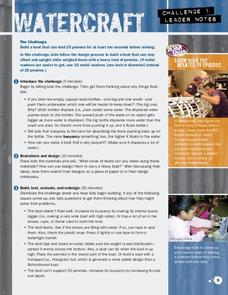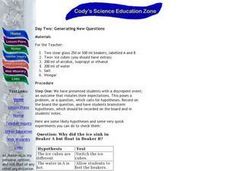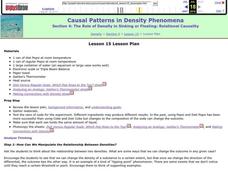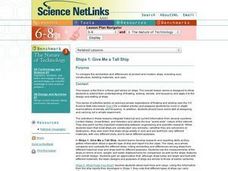Curated OER
Density Studies of the Earth
Density comes to life as investigators place soda cans into containers of various liquids to find if they sink or float. They layer different density liquids, compare densities of different gases, and more. A total of six different...
California Academy of Science
Buoyancy Bulls-Eye
Why does a seastar sink, but a jellyfish float? Through a fun investigation, learners examine the concept of buoyancy using simple household items. The challenge: create neutral buoyancy for an action figure in water. With ample...
DiscoverE
Foil Boats
How many pennies can an aluminum foil boat hold? That is the challenge in a collaborative activity designed to explore the concept of buoyancy. Learners use aluminum foil to build makeshift boats and test the weight they hold before...
Teach Engineering
Clay Boats
Clay itself sinks, but clay boats float. Why? Young engineers build clay boats to learn about buoyancy. They test the weight the boats can hold using washers and then tweak their designs to make improvements, following the engineering...
Concord Consortium
Molecular Sorting
Can scientists sort molecules based on their interaction with oil and water? The simulation demonstrates how this is possible. Pupils decide when to insert a molecule and observe how they sort themselves based on polarity.
Curated OER
Come On Down!
Begin with an introduction to famous deep-sea submersibles. Learners work in groups to gather information on different vessels and then share with the class. Each group then uses water displacement to help calculate the density of...
Exploratorium
Bubble Suspension
Create a cushion of carbon dioxide gas to float some soap bubbles on. Many concepts can be demonstrated through this activity:
Carbon dioxide gas is more dense than air
Bubbles are semipermeable, allowing only carbon dioxide to diffuse...
PBS
Watercraft
Whatever floats your boat—with some additional weight. The first activity in a five-part series challenges pupils to design a boat to hold pennies. Using the design process, learners design, build, and test their boats, making sure they...
Curated OER
Sink or Float?
Students predict and explore to discover which objects sink or float in fresh and salt water, predict how salt affect objects, write predictions on T chart, discuss difference between man-made and natural waters, and graph results.
Curated OER
Radical Raisins!
Students explore the concept of buoyancy through experimentation. Given materials of various weights and composition, they drop them in club soda and determine which substances sink or float. Students discuss their results in terms of...
Curated OER
Day Two: Generating New Questions
Students investigate buoyancy by participating in a lab experiment. In this density lesson, students utilize vinegar and alcohol in beakers and attempt to float different items in them. Students analyze which items float and do not while...
Curated OER
Why Cheerios Don't Sink
Students investigate Archimedes' Principle and show how it relates to density. In this Archimedes' Principle lesson plan, students experiment with a beaker of water, a Styrofoam "boat" and a weight. They predict what will happen when the...
Curated OER
The Role of Density in Sinking or Floating: Relational Causality
Students watch the teacher do a demonstration of density with diet and regular soda. Note: try this first, as different types of artificial sweetener have different densities. Students discuss density and volume. They discuss "Relational...
Curated OER
Give Me a Tall Ship
Sixth graders develop an understanding of floating, sinking, density, and buoyancy and apply it to the design of testing of ships.
Curated OER
Float My Boat
Fourth graders, in groups, experiment with density and the displacement of water by creating and designing their own boats and seeing which boat holds the most centimeter cubes without sinking..
Curated OER
Weight in Water
Students investigate why some materials are able to float while others sink. They carry out a scientific investigation, predict and test their predictions. They record their results in a spreadsheet, and use a forcemeter in another...
Curated OER
Designing and Floating Boats
Middle schoolers participate in an experiment to determine if a toy boat will sink or float. They make the boats out of different materials and determine its carrying capacity by adding pennies. They graph their findings on a classroom...
Curated OER
To Float or Not to Float - A Lesson on Density
Students define density in their own words. In this physics lesson, students calculate density using mass and volume. They explain why some objects sink and some float.
Curated OER
What Floats Your Boat?
Students discover the Archimedes principle through a buoyancy experiment. They measure the water displacement of a lump a clay which is denser than water then reshape the clay into a bowl which floats but displaces more water.
Curated OER
The Floating Golf Ball
Fourth graders discuss density. In this floating golf ball lesson students complete a lab activity on density while working in groups.
Center for Learning in Action
Density
Explore the concept of density within states of matter—gases, liquids, and solids—through a group experiment in which young scientists test objects' texture, color, weight, size, and ability to sink or float.
University of Waikato
Temperature, Salinity and Water Density
The difference between sinking and floating may be a little salt. Young experimenters analyze the effect of salt and temperature on the density of water. They use their results to predict the effect of climate change on ocean ecosystems.
CK-12 Foundation
Going Fishing
Why do some things float and others sink? A creative simulation allows learners to adjust mass and volume of an object to affect its buoyancy in water. A graph records the effect of each manipulation.
CK-12 Foundation
Scuba Training
How does a scuba diver control whether they sink or float? Scholars observe the relationship between absolute pressure and depth below the surface in an undersea simulation. They control the diver size and depth to center of mass to...
Other popular searches
- Sink Float
- Sink or Float
- Sink and Float
- Sink Float Buoyancy
- Sink Float Lessons
- Float Sink Float
- Sink Float Sink
- Fruit Sink Float
- Sink Float Song
- Sink Float Explanations
- Sink and Float Bubbles
- Sink Float Submerge























